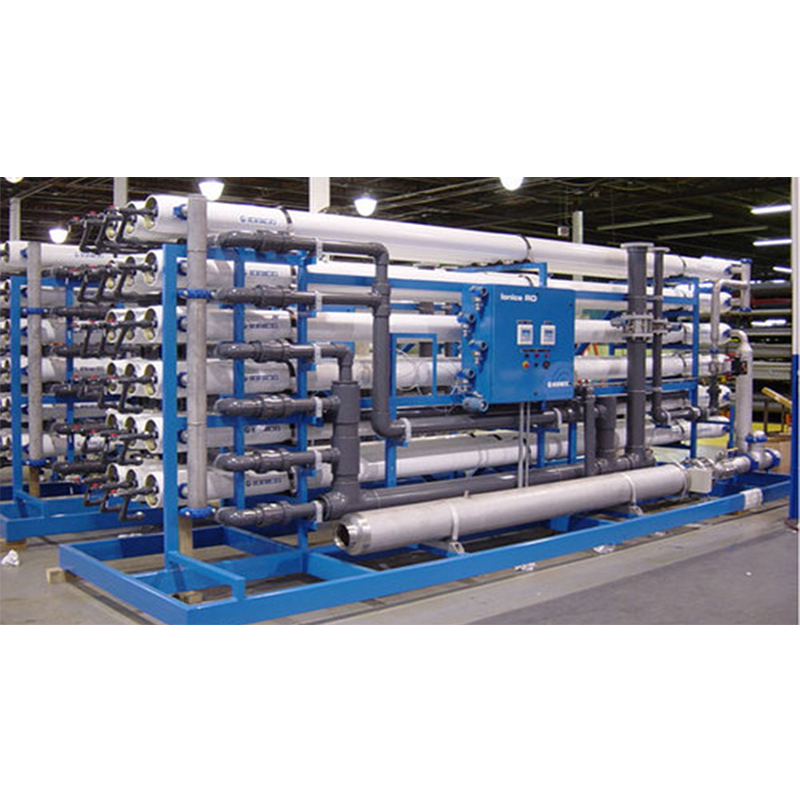
Polysilicon Ultra-pure Water System
Process flow:
Raw water tank → raw water lifting pump → quartz sand filter → activated carbon filter → water softening device → precision filter → primary high pressure pump → primary reverse osmosis → interstage water tank → secondary high pressure pump → intermediate water tank →EDI lifting pump → Microporous filter →EDI system →EDI water tank → polishing mixed bed → water point
Silicon wafer is an indispensable basic material in the modern semiconductor industry, and in the production process of silicon wafer there will be many polluting substances interfere with the final quality of the product, so the production of semiconductor devices silicon wafer need to be strictly cleaned, through cleaning to remove the surface pollution impurities, including organic matter and inorganic matter, otherwise the pollution of trace elements will lead to the failure of semiconductor devices.
Polysilicon is a silicon crystal composed of many silicon atoms and many small grains. Because the orientation of each grain is different from each other, there are a large number of defects. Polysilicon is generally dark silver-gray, opaque, metallic luster, brittle, and inactive at room temperature.
Polysilicon is a high-purity material (also known as reduced silicon) obtained from metallic silicon (industrial silicon) by chemical reaction, purification, and then reduction. At present, the main methods of polysilicon production in the world are improved Siemens method (SiHCl3), new silane method (SiH4), SiH2Cl2 thermal decomposition method, SiCl4 method and other polysilicon production processes.
There are four types of disinfection systems and cleaning systems: low pH type, high pH type, high temperature disinfection type and low concentration oxidation disinfection cleaning type. Separate disinfection and cleaning procedures are only for fresh water, concentrated water and water supply lines, the disinfection and cleaning cycle process can be completed independently, independent recycling procedures can also be carried out at the same time, thus reducing the total use time. Due to the low cleaning flow rate of the polar water cycle, in most cases the cleaning process must be carried out simultaneously with the concentrated water cycle cleaning and the fresh water cycle cleaning. Cleaning the water tank and pump is a must (CIP system). A total of five cleaning lines are required: two inlet (fresh water inlet and concentrated water inlet) and three outlet (fresh water outlet, feed water outlet and concentrated water discharge).
Equipment features:
1. Low energy consumption, high utilization rate of water resources, and effective control of equipment operating costs.
2. The equipment is fully automatic microcomputer control, when there is a fault in the operation process, it will stop in time, and has automatic protection function.
3. The membrane component part is made of international imported materials, showing higher solute separation rate and transmission rate.
4. The equipment has a high degree of integration and is easy to expand, which can increase the number of membrane filtration and thus increase the processing capacity per unit time.
5. There are no vulnerable parts in the system as a whole, and there will be no large number of maintenance situations to ensure the long-term effective operation of the equipment.
6. The structure is reasonable to reduce the floor space used by the equipment.
7. The equipment can be continuously produced, snap installation mode, fast and convenient maintenance.
8. The effluent water quality is stable, the practical design of the equipment is strong, easy to use daily.
9. There is no need to deal with waste acid and alkali, and there is no need for acid and alkali regeneration, which greatly saves daily operating costs.
Implementation standards:
GB6682-2000 China National Laboratory water GB6682-2000
Determination of trace chloride ions, nitrate ions, phosphate ions and sulfate ions in electronic grade water -- ion chromatographic method
GB/T 11446.5 -- 1997 Atomic Absorption spectrophotometric test method for trace metals in electronic grade water
GB/T 11446.3 -- 1997 General principles for electronic grade water test methods
GB/T 11446.6 -- 1997 Spectrophotometric test method for electronic grade silica in water
GB/T 11446.4 -- l997 electronic grade water resistivity test method
GB/T 11446.9 -- 1997 Instrumental test method for electronic grade particles in water
GB/T 11446.8 -- 1997 Test method for total organic carbon in electronic grade water
JBT 7621-1994 High purity water for power semiconductor device process
ASTM D5127-2007 United States Water Quality Standard for Electronics and Semiconductors
GBT11446.1-2013 Electronic grade ultra-pure water China national standard
